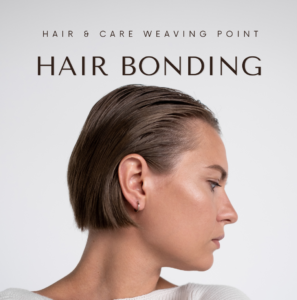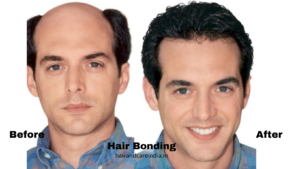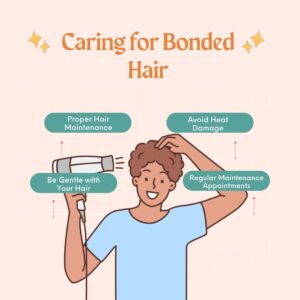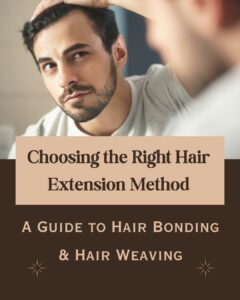Welcome to Hair and Care Weaving Point | Free Shipping And COD On All Orders
Hair Bonding: A Guide to This Innovative Hair Treatment
Hair bonding is a type of hair treatment that uses specialized products to repair and strengthen damaged hair. The treatment/therapy works by penetrating the hair shaft and rebuilding the bonds that have been broken, which can be caused by a variety of factors, including heat styling, chemical processing, and environmental damage.
Hair bonding is a relatively new treatment, but it has quickly become popular among celebrities and everyday people alike. The treatment is said to be effective in repairing even the most damaged hair and can provide long-lasting results.

If you are considering hair bonding, talking to your hairstylist is important to see if the treatment is right for you. They can help you choose the right products and techniques for your hair type and condition.
This post will discuss the benefits of hair bonding, how the treatment works, and what to expect during and after the procedure. We will also provide tips on choosing the right hair-bonding products and techniques for your hair type.
Hair bonding is the right treatment if you are seeking a way to repair and strengthen your damaged hair. Read on to learn more about this innovative hair treatment.
There are many benefits to hair bonding, including the following:
- Reduced hair breakage
- Improved hair strength
- Reduced frizz
- Increased shine
- Improved manageability
Benefits of Hair Bonding
- Reduced hair breakage: Hair bonding can help to reduce hair breakage by up to 85%. This is because the treatment repairs the bonds that hold hair together, making it less likely to break. A number of factors, including chemical processing, heat styling, and environmental damage, can cause hair breakage. Hair bonding can help to repair the damage and prevent further breakage.
- Improved hair strength: Hair bonding can also improve hair strength. This is because the treatment rebuilds the hair’s natural proteins, which makes it stronger and more resistant to damage. Strong hair is less likely to break and will also be more manageable and easier to style.
- Reduced frizz: Hair bonding can also help to reduce frizz. This is because the treatment smooths the hair’s cuticle, which helps to prevent the hair from becoming dry and brittle. A number of factors, including humidity, heat styling, and chemical processing, can cause frizzy hair. Hair bonding can help to reduce frizz and make the hair look smoother and more manageable.
- Increased shine: Hair bonding can also increase shine. This is because the treatment repairs the hair’s natural oils, which helps to keep the hair looking healthy and shiny. Hair that is shiny is more attractive, and it will also be easier to style.
- Improved manageability: Hair bonding can also improve manageability. This is because the treatment makes the hair more pliable and easier to style. Manageable hair is easier to brush and style and will also be less likely to break.
In addition to the benefits listed above, hair bonding can also help to:
- Protect hair from further damage: Hair bonding can help to protect hair from further damage by creating a barrier around the hair shaft. This barrier can help to protect the hair from heat styling, chemical processing, and environmental damage.
- Restore hair’s natural luster: Hair bonding can help to restore hair’s natural luster by repairing the damage that has been done to the hair’s cuticle. It can help to make the hair look healthier and more vibrant.
- Reduce the appearance of split ends: Hair bonding can help reduce the appearance of split ends by repairing the damage done to the hair’s ends. It can help to make the hair look smoother and more manageable.
Hair bonding is a safe and effective way to repair and strengthen damaged hair. If you are seeking a way to improve the health and appearance of your hair, hair bonding may be the right treatment for you.
Discover the advantages of hair bonding treatment.
Hair bonding offers a number of advantages over other types of hair treatments, including:
- Long-lasting results: Hair bonding results can last up to six months, depending on your hair type and how often you style it.
- Immediate results: You will see results from hair bonding treatment immediately. Your hair will look and feel healthier, smoother, and shinier.
- No downtime: You can resume your normal activities immediately after a hair-bonding treatment.
- Minimally invasive: Hair bonding is a minimally invasive treatment that does not require any cutting or shaving.
How to choose the right hair bonding treatment for you
Here are some tips on how to choose the right hair-bonding treatment for you:
- Consider your hair type and texture. Some hair bonding treatments are better suited for certain hair types than others. For example, if you have fine hair, choose a lightweight treatment that won’t weigh your hair down.
- Think about the level of damage your hair has. If your hair is severely damaged, you may need a more intensive treatment than if your hair is only mildly damaged.
- Consider your budget. Hair bonding treatments can range in price from affordable to expensive. Choose a treatment that fits your budget and your needs.
- Read reviews of different hair bonding treatments before you make a purchase. It will help you understand what others think of the treatment and whether it is right for you.
- Talk to your hairstylist. They can help you choose the right hair bonding treatment for your hair type and condition.
How to get the most out of hair bonding treatment
To get the most out of hair bonding treatment, it is important to follow the instructions provided by your stylist. You should also avoid using heat styling tools and harsh chemicals on your hair for at least 24 hours after the treatment.
In addition, you should use a shampoo and conditioner that are designed for damaged hair. You should also avoid washing your hair too often, as this can strip away the treatment and make your hair more susceptible to damage.
Conclusion
Hair bonding is a safe and effective way to repair and strengthen damaged hair.
Here are some additional tips for getting the most out of your hair-bonding treatment:
- Choose a reputable salon or stylist who is experienced in hair bonding treatments.
- Make sure to follow the instructions provided by your stylist after your treatment.
- Avoid using heat styling tools and harsh chemicals on your hair for at least 24 hours after treatment.
- Use a shampoo and conditioner that are designed for damaged hair.
- Avoid washing your hair too often, as this can strip away the treatment and make your hair more susceptible to damage.
- Get regular trims to remove split ends, making your hair look dry and damaged.
- Eat a healthy diet and drink plenty of water to keep your hair healthy from the inside out.
- Get enough sleep, as this can also help improve your hair’s health.



